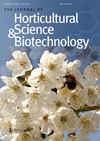对东方百合×小喇叭杂交根的转录组分析揭示了生长素相关基因和胁迫相关基因参与皮氯兰诱导体细胞胚胎发生的过程
IF 2.1
4区 农林科学
Q2 HORTICULTURE
Journal of Horticultural Science & Biotechnology
Pub Date : 2019-05-04
DOI:10.1080/14620316.2018.1500086
引用次数: 5
摘要
摘要高效的体胚发生起始系统是东方百合×小喇叭杂种克隆繁殖和遗传转化的关键。为了阐明SE诱导的潜在机制,我们在4个不同时间对根进行了从头转录组测序(0天,对照;20 d,胚性愈伤组织诱导(ECI) 1;40天,ECI2;55天,ECI3)。ECI1与对照组、ECI2与对照组、ECI3与对照组的差异表达基因(deg)分别为4621、7582和7427个。基因富集分析显示54个显著的deg。进一步分析发现,生长素相关基因ARF9/15/16、脱落酸相关(aba)基因PYL4/9以及胁迫相关转录因子WRKY26、MYB36、NAC100、bHLH2/5/18/112和HSP90在ECI1阶段的转录水平均有所升高。ABI5可以影响应激反应基因的表达。本文章由计算机程序翻译,如有差异,请以英文原文为准。
Transcriptome analysis of Lilium Oriental × Trumpet hybrid roots reveals auxin-related genes and stress-related genes involved in picloram-induced somatic embryogenesis induction
ABSTRACTHighly efficient somatic embryogenesis (SE) initiation systems are crucial for the clonal propagation and genetic transformation of Lilium Oriental × Trumpet hybrid. To elucidate the underlying mechanism of SE induction, we conducted de novo transcriptome sequencing of the roots at four different times in relation to SE initiation (0 days, control; 20 days, embryogenic callus induction (ECI) 1; 40 days, ECI2; 55 days, ECI3). A total of 4621, 7582, and 7427 differentially expressed genes (DEGs) were identified from the ECI1 vs. control, ECI2 vs. control, and ECI3 vs. control comparisons, respectively. The gene-enrichment analysis revealed 54 significant DEGs. Further analysis showed that the transcript levels of the auxin-related genes ARF9/15/16, the abscisic acid-related (ABA-related) genes PYL4/9, and stress-related transcription factors, including WRKY26, MYB36, NAC100, bHLH2/5/18/112, and HSP90, were increased at the ECI1 stage. ABI5 can influence the expression of stress-responsive genes as a...
求助全文
通过发布文献求助,成功后即可免费获取论文全文。
去求助
来源期刊
CiteScore
3.90
自引率
5.30%
发文量
67
审稿时长
3 months
期刊介绍:
The Journal of Horticultural Science and Biotechnology is an international, peer-reviewed journal, which publishes original research contributions into the production, improvement and utilisation of horticultural crops. It aims to provide scientific knowledge of interest to those engaged in scientific research and the practice of horticulture. The scope of the journal includes studies on fruit and other perennial crops, vegetables and ornamentals grown in temperate or tropical regions and their use in commercial, amenity or urban horticulture. Papers, including reviews, that give new insights into plant and crop growth, yield, quality and response to the environment, are welcome, including those arising from technological innovation and developments in crop genome sequencing and other biotechnological advances.

 求助内容:
求助内容: 应助结果提醒方式:
应助结果提醒方式:


